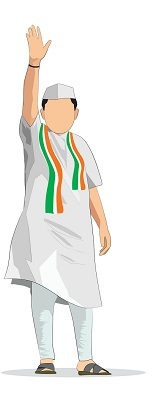
 Data Structure
Data Structure Networking
Networking RDBMS
RDBMS Operating System
Operating System Java
Java MS Excel
MS Excel iOS
iOS HTML
HTML CSS
CSS Android
Android Python
Python C Programming
C Programming C++
C++ C#
C# MongoDB
MongoDB MySQL
MySQL Javascript
Javascript PHP
PHP
- Selected Reading
- UPSC IAS Exams Notes
- Developer's Best Practices
- Questions and Answers
- Effective Resume Writing
- HR Interview Questions
- Computer Glossary
- Who is Who
What is the full form of DMK?
Introduction
Dravida Munnetra Kazhagam (DMK) creation and evolution cannot be traced without tracing the formation and activities of the Justice Party.
Today, DMK is one of the most important parties of Tamil Nadu. It is also the state's ruling party. Hence, in this article we will discuss the rise of the party, its ideology and its activities since its inception.
History behind formation of DMK
The effect of the British colonial administration on Tamil Nadu, located in the southern part of India was that the high-caste non-Brahmins of the state were losing their political, regulatory and financial control in the state which they previously had. During this time, the Brahmins, whose financial and political significance had been limited, were able to improve their situation by taking the opportunities offered by the Britishers.

The Brahmins were inclined towards education and hence were ready to be trained for the diverse echelons of the bureaucracy and other professions offered by the Britishers. This created a scenario where the Brahmin community comprising as it were 3-5 percent of the whole populace of Tamil Nadu had risen to occupy several positions under the British government like clerk, administrative and others.
The non-Brahmins of Tamil Nadu found that the Brahmins were proficient enough and were becoming an obstacle for their advancement. Hence, the non-brahmins, utilised political resources and took the help of the Justice Party. Experts say that in spite of the fact that the Justice Party claimed to stand for the underprivileged segments of the non- Brahmin community, and for the entire population in reality it demonstrated support for the high-caste non-Brahmins.
By the late 1930s, the Justice Party started supporting the Briahmin community in return for their support towards the party. According to experts they changed this position to portray the party as a non-communal party.
Formation of DMK
During the 1940s, the Justice Party was transformed into the Dravida Kazhagam (DK) party. This was conducted under the leadership of Periyar E. V. Ramaswami Naicker. This party was created with a belief system that rejected Hinduism as inegalitarian. It protested against the Brahmins and tried to uplift the non-Brahmins.
Naicker emphasised on social change through radical resistance and restricted political support of the Brahmins. Inside the DK, tussle between different ideologies started taking place between two groups. One of them was driven by C.N. Annadurai who favoured taking part in electoral politics and supported the mass mobilisation of the backward class of the Hindu communities. This group formed the Dravida Munnetra Kazhagam (DMK) in 1949.
Political Ideology of DMK
The DMK concentrated its endeavours on mobilising the backward classes, since their main aim was the advancement of these classes and maintaining their superiority. The DMK shifted their focus to cultural nationalism. They started to strengthen the base of Tamil dialect and culture. They aimed to challenge the superiority of North Indian culture and Hindi language.
The DMK stirred sentiments for Tamil independence and by 1963, when the central government put a ban on separatism as a political ideology the DMK renounced their political goal of creating a separate state named Dravida Nadu. Since then the DMK's objective had turned to the accomplishment of genuine and significant independence inside the Indian alliance.
Current status and impact of DMK
The spread of the DMK party organisation through the 1950s was alongside the development of close relationships between the party's members and journalism, film and theatre. Experts believe that DMK's ideas were propagated through the media. By the late 1950s, DMK ideas were also popularised through films.
The DMK also supported the concerns of the industrial workersb. In the 1950s, started gaining support from the trade unions. The party's activities during the 1960s can be largely seen through its involvement in supporting the demands of industrial workers, peasants and agriculture in the legislative assembly.
The common methods of DMK mobilisation was to keep a check on the rise of Congress and mobilise modern voters. With this aim in mind they also made coalitions during 1967 and 1971.
Conclusion
The DMK through its policies and ideas portrayed itself as a party of the common man. This was aimed at the rising urban lower-middle which included the educated, unemployed youth; the agriculturist; and especially the backward classes. Hence, we can say that since its inception the party's ideology evolved and changed through different phases of Tamil history.
FAQs
Q1. Who is C.N.Annadurai?
Ans: C.N.Annadurai is popularly known as Anna. He was a politician in the state of Tamil nadu who has also served as the first Chief Minister of Tamil Nadu.
Q2. Who is the Chief Minister of Tamil Nadu?
Ans: M.K. Stalin is the Chief Minister of Tamil Nadu. He is also the President of DMK. He is the 8th CM of Tamil Nadu and the son of another popular politician named M. Karunanidhi.
Q3. Who is Periyar E. V. Ramaswami Naicker?
Ans: Periyar E. V. Ramaswani Naicker is popularly known as Periyar. He was a social activist and the person behind the Dravidian Movement.

